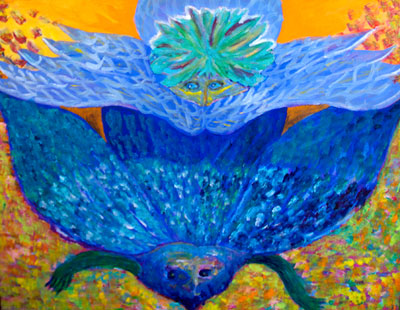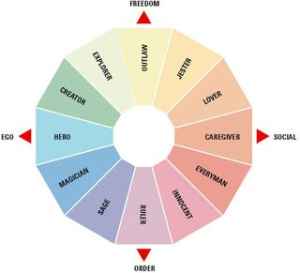 Artwork Credit: Janice Geller, MA, LPC
Artwork Credit: Janice Geller, MA, LPC The words “archetype” and “archetypal” have become so common that you have probably encountered them in articles, books, films, and the like. But what do these words really mean, particularly in regard to psychology?
Generally speaking, archetypes relate to universal symbols, characters, or motifs that evoke deep meaning. Some examples of well-known archetypes include the Wise Old Man (think Yoda from Star Wars or Mr. Miyagi in The Karate Kid), the Outlaw (such as the eponymous duo from Thelma and Louise), and the Caregiver (picture Julie Andrews in Mary Poppins). While archetypes are everywhere, it is not as well known that we can actively work with them to achieve greater self-awareness and to activate psychological growth. Read on to find out more about archetypes and how to unleash their power.
Swiss psychiatrist and psychotherapist Carl Jung is responsible for bringing the concept of archetypes to the field of psychology, according to psychiatrist, Jungian analyst, and author Jean Shinoda Bolen, M.D. While Jung did not coin the term “archetype,” he developed a theory that described archetypes as primordial patterns that stem from what he called the collective unconscious, or the deep layer of the unconscious that transcends the individual and traverses humanity. Jung saw the collective unconscious as the most essential source of inner empowerment, transformation, and wholeness, writes psychotherapist and author Robert Hopcke.
Archetypes can be thought of as containers. These containers hold interconnected figures, motifs, or themes that reappear in myths, folktales, religions, literature, and the arts, spanning widely across cultures and eras. The figures, motifs, and themes are not the archetypes themselves; they are the content of the archetypes.
For example, consider the Trickster archetype, which contains such clever, rule-breaking figures as Loki from Norse mythology, the coyote from various Native American stories, and the kitsune (fox) from Japanese folklore, as well as symbols such as the court jester’s hat and the Magician card of the tarot.
The Trickster often appears in stories as a character who holds potent wisdom but does not share it in a straightforward way. Rather, the Trickster will play a prank, make a joke, or even shapeshift from one form to another in order to reveal the deeper lesson to be learned, as well as challenge the protagonist to shed the ego and cultivate new ways of being. Often represented as male, the Trickster may play tricks on humans, animals, and even deities. The Trickster invites us to be playful and to not take matters too seriously, as well as embrace paradox, tolerate uncertainty, and have openness to new perspectives.
The Cheshire Cat in Lewis Carroll’s Alice in Wonderland is an example of a Trickster archetype figure—the cat confirms that Wonderland is a place of madness and that Alice will need to rely on her instincts and animal guides to make it through.
More Examples of Archetypes
The content of some archetypes can be personified as figures, such as the Trickster example given above. Here are a few more examples of personified archetypal figures:
Other archetypes may relate to universal life aspects or processes, such as the following:
What Could This Mean for Your Psychological Growth and Wellness?
According to Hopcke, we develop psychologically when we allow the content of the archetypes to enter our conscious awareness, and when we foster a relationship between our two levels of existence: the everyday (personal) and the archetypal (collective). When we find that we relate to certain myths, folktales, and stories, we can draw strength, insight, and comfort from them, as they provide a sort of “human map” for us to navigate and better understand our lives. Further, Dr. Bolen writes that when we sense that something we are undergoing has a mythic aspect, this knowledge can also activate a deep well of creativity.
Ways to Work with Archetypes
In one of his lectures, Jung is quoted as saying, “If you put yourself into the icon, the icon will speak to you…. It has a magic effect.” In other words, if you engage with the archetype, it will reveal its message to you. There are several techniques and models for engaging with archetypes, including active imagination, dialoguing, and the four cardinal orientations. Some techniques may be used in an individual’s self-guided personal work. Other techniques are primarily used by mental health professionals.
To that end, one word of heedfulness: self-guided work with archetypes may stir up strong emotions, memories, and thoughts. If you have difficulty with what emerges and feel overwhelmed, consult a mental health professional to help you navigate the process. If you want to find a therapist who specializes in working with archetypes, search for “Jungian therapist,” “expressive arts therapist,” or “analytical psychologist.”
Active Imagination
Active imagination, in its more formal sense, is a technique used primarily by Jungian-oriented clinicians to help people access inner wisdom by connecting the unconscious and conscious minds. In this technique, the therapist guides the client through a visualization where the client allows the images to unfold organically (i.e., with the unconscious mind), as opposed to trying to exert influence on the images (i.e., with the conscious mind). An example of active imagination is when a client tells his or her therapist about a dream about a boat in the ocean. The therapist may use the dream images as a starting point, having the client enter a scene from the dream and observe what unfolds in real time during the visualization.
In its less formal sense, active imagination can be used in a variety of ways to help people to derive meaning from the art that they make. For example, an expressive arts therapist may invite a client to do active imagination in the form of making a physical movement in response to a drawing that the client created. According to psychologist and expressive arts therapist Cathy Malchiodi, Ph.D., “Many in the field of art therapy agree that art making itself can be a form of active imagination if one allows images to unfold spontaneously without judgment, control, or intention for specific outcomes.”
Dialoguing
Dialoguing is a variation on active imagination. People who may use this technique include those doing self-guided personal work or expressive arts therapists. In dialoguing, you first speak to the image as if it’s a person. Then, you speak as the image.
Four Cardinal Orientations
Have you ever wondered what archetype most resembles your personality? Most people have several archetypes reflected in their personality, with one archetype in particular playing a dominant role. These archetypes may also shift over time. While many different archetypes exist, Jung distilled them into 12 primary archetypes. He divided these 12 archetypes into four groups, or cardinal orientations, that organize the archetypes according to their motivating orientation: ego fulfillment, freedom, socialness, and order.

The four cardinal orientations present a model of understanding ourselves through the lens of these 12 primary archetypes and their related motivations. For example, the Outlaw, who is driven to break rules and challenge established conventions, is motivated by an orientation toward freedom. The other two archetypes oriented toward freedom are the Explorer and the Jester. By looking at the ultimate orientation of the archetypes at work in yourself, you can achieve greater understanding of your goals, strengths, weaknesses, and core desires.
Conclusion
Archetypes are containers that hold powerful patterns of symbols, stories, myths, and metaphors. By investigating the archetypal patterns that emerge in our lives—whether it’s analyzing a dream, participating in a psychotherapy session incorporating active imagination, or using another method—we can unlock the archetypes’ power. In doing so, we can access deeper levels of insight, wisdom, and creative energy, and gain a level of understanding that exists beyond the limits of the rational, linear mind. The spark of insight that can come from connecting to an archetype can ultimately help us hone in on the essential truth about a matter. And when we connect to our essential truth, we are that much more whole.
Resources
Gods in Everyman: A New Psychology of Men’s Lives and Loves by Jean Shinoda Bolen, M.D.
Goddesses in Everywoman: A New Psychology of Women by Jean Shinoda Bolen, M.D.
A Guided Tour of the Collected Works of C.G. Jung by Robert H. Hopcke
Analytical Psychology: Its Theory and Practice—The Tavistock Lectures by Carl Gustav Jung
Jung to Live By by Eugene Pascal, Ph.L.
Boundaries of the Soul: The Practice of Jung’s Psychology by June Singer
About This Contributor: Chiara Viscomi, MA, LMFT (MFC #104851) is a practicing licensed marriage and family therapist in California. She received her master’s in counseling psychology with a certificate in creative expression at Sofia University (formerly known as the Institute of Transpersonal Psychology). Prior to that, Chiara received a BA in psychology and a BFA in drama at the Experimental Theatre Wing at New York University’s Tisch School of the Arts. She is passionate about expressive arts therapy, Jungian psychology, transpersonal psychology, and integrative approaches to wellness. In addition to her clinical work, Chiara is a longtime professional writer and editor in the healthcare field, as well as a musician and performing artist.
To find out more about her approach to psychotherapy, visit www.lapishealingarts.com. [Bio updated June 2018.]

Leave a reply
You must be logged in to post a comment.